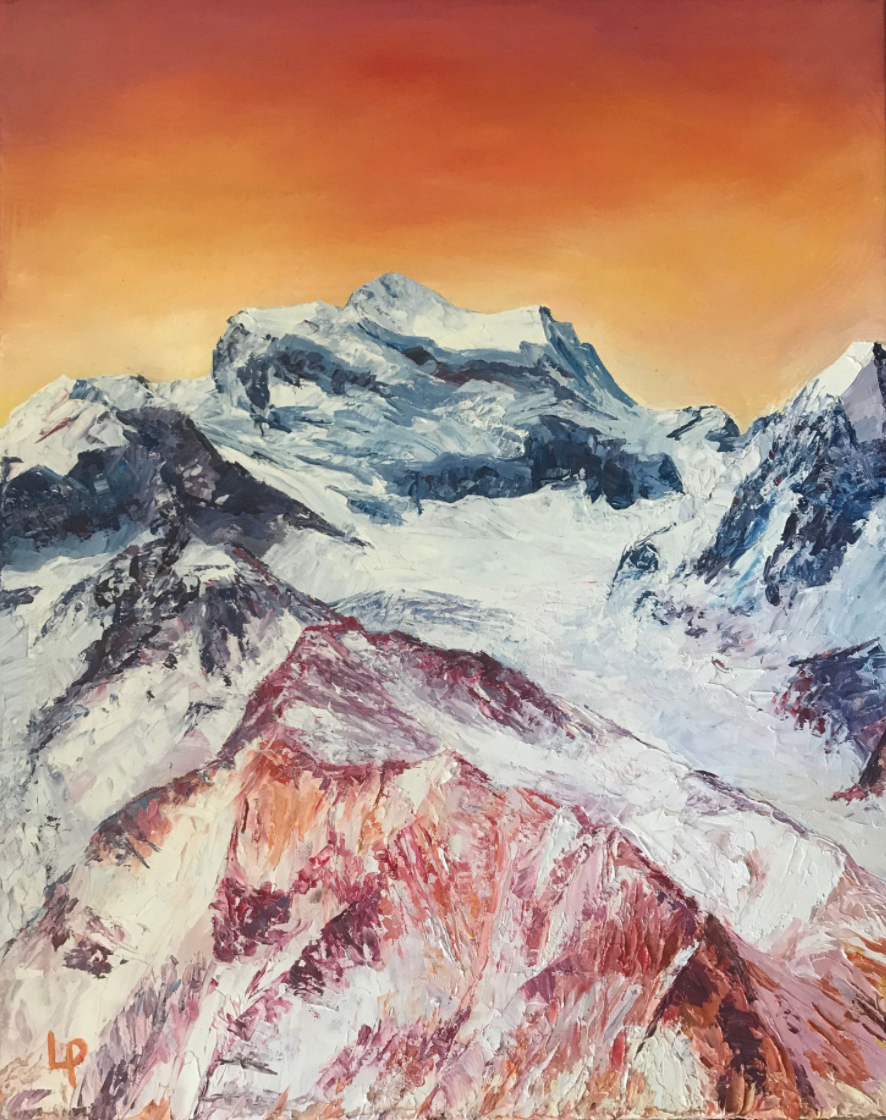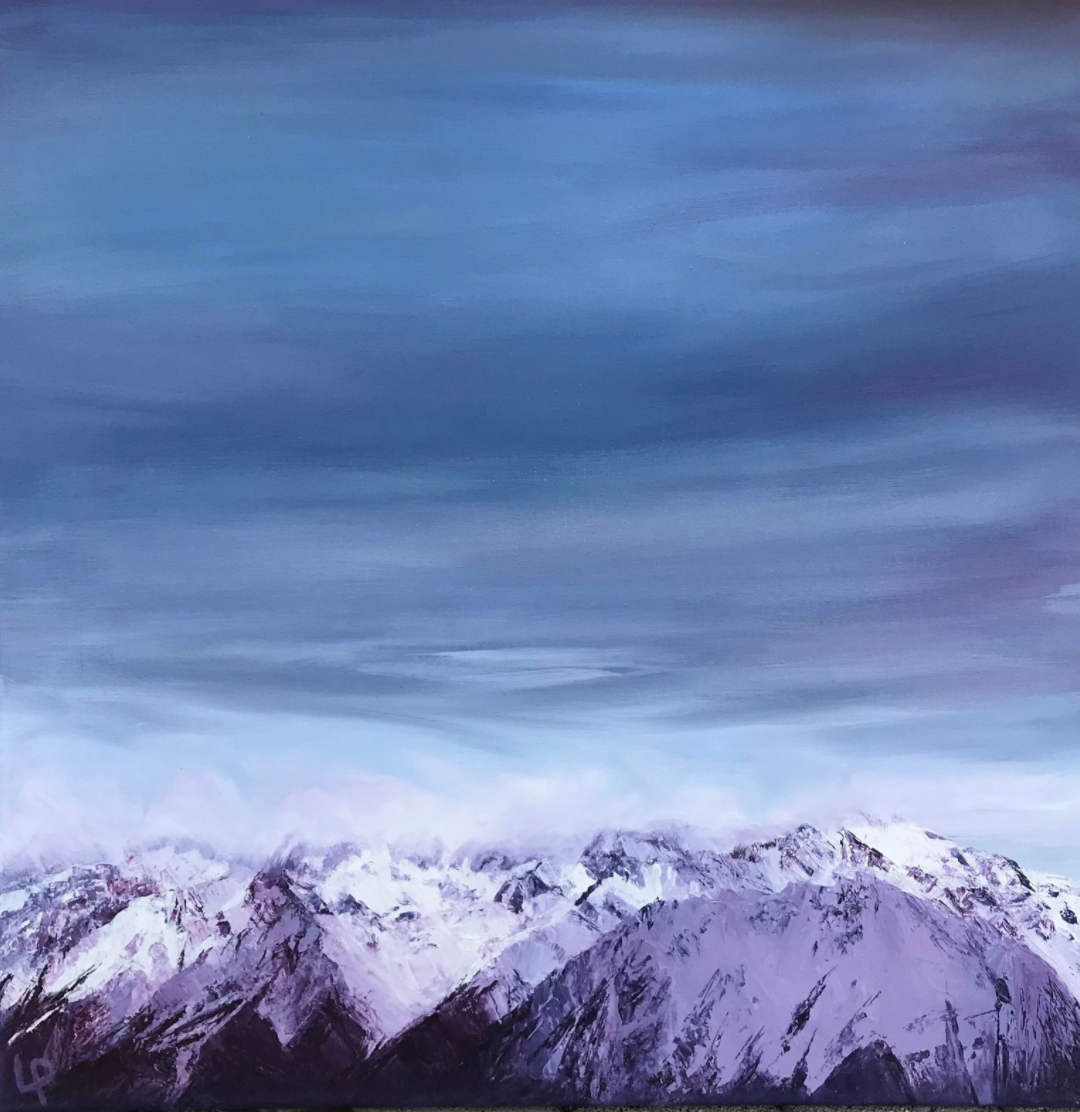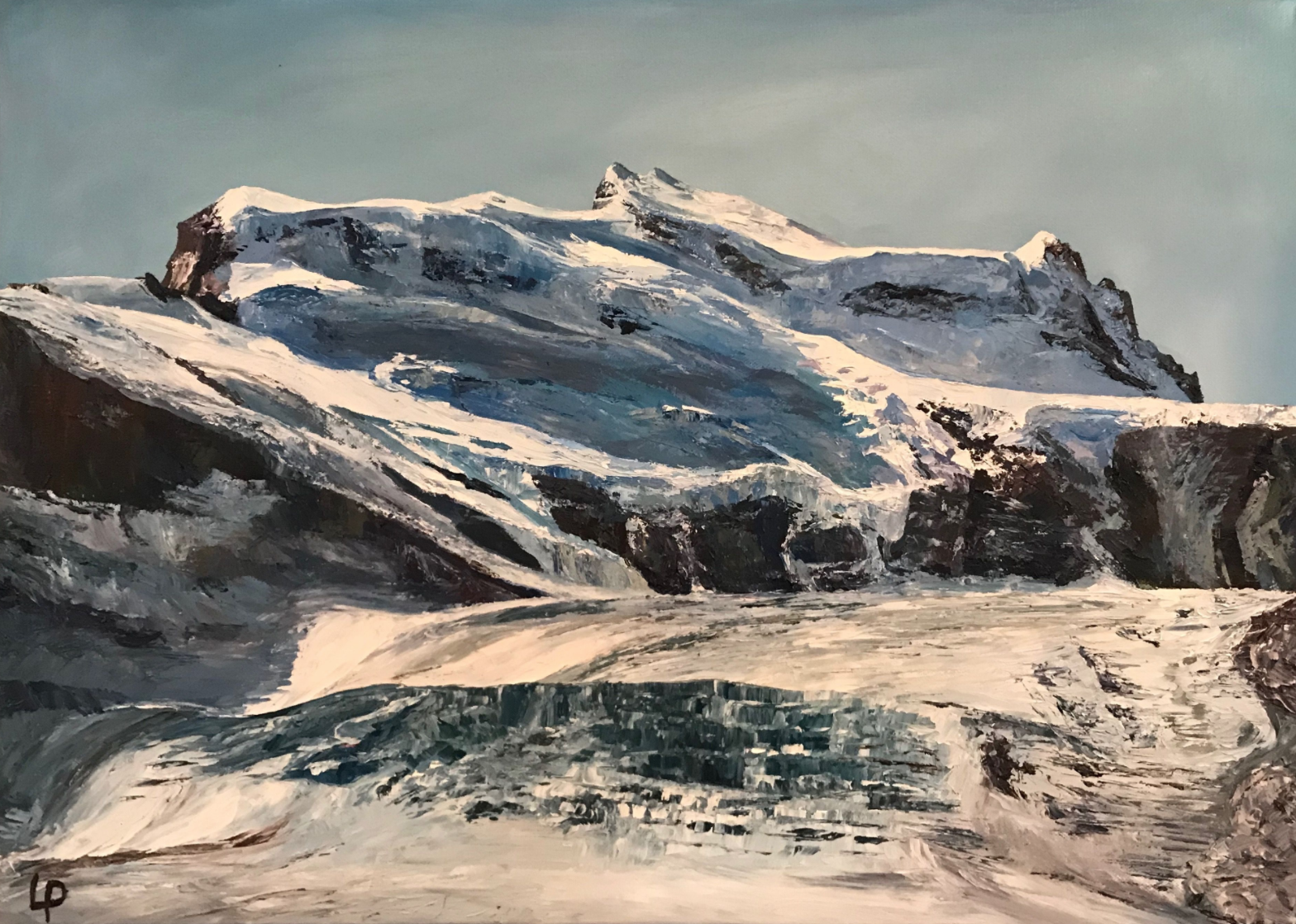LANDSCAPE PAINTER LAURA PORTEOUS EXPLAINS HOW THE SWISS ALPS INSPIRE HER CREATIVE PROCESS AND HOW THE ISSUE OF CLIMATE CHANGE IS EXPRESSED IN HER WORK
An underlying message of climate change runs within the changing dramatic glacial mountains depicted in the work of contemporary landscape painter Laura Porteous. “My intention is to ensure the mountains of the area are recognisable down to every rock-band, while stamping my projections on how the weather or climate presents them to me at any given time.”
Aside from her immediate surroundings, she also paints landscapes of destinations she believes require attention and awareness.
Laura is primarily a self-taught artist; however, she did gain formal training in printmaking while studying at Gray’s School of Art in Aberdeen.
Originally from Scotland, Laura now resides in the alpine village of Verbier, Switzerland surrounded by beautiful mountain vistas. She sells work to both local and international collectors and regularly exhibits her work in Switzerland. She is available for commission upon request.
We are delighted to feature her work in Curatorial Volume.2, Leaders in Contemporary Art, out now.
“For me, creating art is about really appreciating what is in front of me. My work is not necessarily intended to be a kind of realism, just a celebration of what I see.”
© Laura Porteous - Corbassière
Hi Laura, thanks for taking the time to talk to us today, please can you introduce yourself and explain how your relationship with art began?
I think I was really visually observant from a very young age, noticing things others didn’t, and so I naturally ended up drawing with much more awareness than the other kids in my class. Until I had to study art in a really structured way, I just loved recording what I saw.
For me, creating art is about really appreciating what is in front of me. My work is not necessarily intended to be a kind of realism, just a celebration of what I see. I believe it helps people relate to it if they can recognise where or what it is so that is important to me, but I like to try and force the viewer to see something different or something other than the obvious. If I can show them how I saw it, they can have a new insight maybe.
© Laura Porteous - Storm Over Rogneux
“I can never get bored of it so maybe that’s why I see so many vibrant colours around it and whatever conditions I find it in.”
We are excited to feature your work in Curatorial Volume.2, Leaders in Contemporary Art - can you tell us about the pieces you have featured, “Storm Over Rogneux”, “Winter Rogneux”, “Low Sun Up High and “Bec des Rosses III”.
“Storm over Rogneux” and “Winter Rogneux” are just two of my series featuring Mont Rogneux. This mountain is the one I see directly facing south from my house and it’s so imposing on the area. I have painted it from a few different angles and contexts. I can never get bored of it so maybe that’s why I see so many vibrant colours around it and whatever conditions I find it in. The storm to me, especially as a skier is very exciting because I know more snow is coming, so my projections were very much a celebration that day and not doom and darkness as the view could be perceived by others.
© Laura Porteous - Winter Rogneux
The sunny day in “Winter Rogneux” and in “Bec des Rosses III” is also about how the shadows in the snow are never dull. Snow might look white, but as it’s made up of translucent particles, how can it be? Light is refracted and reflected so I never like to use any kind of black in my palette. I see it as a lazy way to create shade or darkness, and also a naïve way of seeing it when there is so much more to it than that. Not to mention how technically it can kill the other colours in a painting.
Le Bec des Rosses is a mountain accessible within the Verbier 4 Vallées ski area. I consider it to be so intimidating and steep that I am in awe constantly of its dominant posture over the slopes below it. If you are skilled enough and brave enough, it is skiable in ideal conditions. It’s the face that is skied by the big mountain free-riders in the final stage of the Freeride World Tour, a competition for those tough enough to take it on. I hope to convey its dominion over the viewer with the angle I have painted it and the shadows it imposes over its face having it’s back into the sun at all times.
“I hope to convey its dominion over the viewer with the angle I have painted it and the shadows it imposes over its face having it’s back into the sun at all times. ”
© Laura Porteous - Bec des Rosses III
Finally, “Low sun, up high” is a real first-hand account on how golden the glaciers can turn in the low sunlight on the sunset of a hot summer evening of hiking. It’s just magnificent. (Sometimes they turn florescent pink and orange.) The mountains featured are famous in the area and very distinctive in their shapes and their glacial summits. The golden colours portray the sunlight as the perfect symbolic crown for such highly celebrated peaks.
© Laura Porteous - Low sun, up high
“I see beautiful or unusual things happen in the views that I paint, and I wish to convey what I have seen”
Can you describe your creative process?
I see beautiful or unusual things happen in the views that I paint, and I wish to convey what I have seen. The naked eye for most others, can only process a limited amount and my aim is to open the eyes of the viewers further, to see what I see. You could describe what I do as a kind of log, or a journalistic approach.
© Laura Porteous - Turbulence
What media and tools do you use in your work, and what features do they have that make them particularly suited to your creative practice?
I paint from referencing photos I have taken myself and remember how I felt when I took them. The changes in colours that I make come from my memory and imagination and not from editing the photos. This way I can be more liberal in the process. It could change during the first few stages of applying colour but sometimes it’s more concrete in my head of which ones will work best to describe how I have seen something. It is sometimes very simple, other times very specifically obscure.
I paint the sky and the weather conditions with a brush and to create contrasting texture and layers, the mountains and rocks come forward with the bolder application and strokes with the palette knife.
“I am open to evolving all the time. I’m definitely not set in stone as the artist I describe myself to be.”
How has your visual style evolved throughout your career?
I used to paint meticulously with a brush. I was so intent on recording absolutely everything I could see that it felt both satisfying and confining to get it all in as it got a bit obsessive. I felt trapped with it, so I started to use my fingers to paint so that I physically couldn’t anymore. Taking away that ability actually liberated me to shift my focus onto the parts I found more important and fundamental. Then one day, a friend gave me a palette knife to try. I haven’t looked back!
Colour has always been the most important thing for me. Though there are many things that can create drama and attitude or subtlety and calm in a piece of work, I would argue that it is the use of colour that can be the most pivotal in the expression. That is just my opinion, but who is to say I’ll have a different opinion after exhausting every avenue of bending my use of colour?
I am open to evolving all the time. I’m definitely not set in stone as the artist I describe myself to be. I am excited at the idea of future personal evolution to find new ways of sending my message through my painting.
© Laura Porteous - Summer Rogneux
“Climate change is presented in so many other ways throughout the world but shrinking fresh-water storage is one of the biggest threats there is, to preserving life as we know it.”
Climate change is a theme throughout your body of work. Can you offer three tips, tools or reading materials for people, particularly artists who are looking to become more climate aware?
Just look around, observe. Wherever you are, there is something. Smog, haze, forest fire, drought, rising temperatures from deforestation, rising sea levels from ice caps crumbling, diminishing numbers of species whose habitats are under threat and more. I don’t describe myself to be any kind of leader in creating awareness. Just that I am aware, and hopefully others can pick up on what I see when they witness my artwork. As a winter lover and skier, my fascination is with the mountains covered in snow and ice. There is plenty of material out there to read up on it, but just from observing the history of how much glaciers have retreated, just in the Swiss Alps over the last 50 years, it is clear that massive change is afoot. Climate change is presented in so many other ways throughout the world but shrinking fresh-water storage is one of the biggest threats there is, to preserving life as we know it.
“ I don’t necessarily paint to create a sense of urgency or depressing outer view of the natural world, my main intention is to celebrate and engage with it”
If someone can appreciate my subject matter, they ought to have some appreciation for the surrounding natural climate and how quickly it seems to be changing. I don’t necessarily paint to create a sense of urgency or depressing outer view of the natural world, my main intention is to celebrate and engage with it. I feel that perhaps that can have a more balanced and positive effect in adapting one’s personal way of life and behaviour around climate change.
For other artists using the same materials as I do: Something simple like, not throwing your dirty turpentine down the sink or toilet is just responsible. Dispose of it properly at the local dump and don’t be lazy with your clean-up, as the chemicals will eventually end up in your local river or the sea.
Don’t use plastic cups excessively or styrofoam picnic plates for palettes and mixing. Surely a creative person can come up with some other ideas on how to operate responsibly. I’ve seen so many do this when it is unnecessary and keeping a stock of this kind of disposable stuff just creates more demand. I don’t have all the answers but I do my best. I am lucky I live in a country with waste incineration that even redistributes the energy from that, back into the grid.
© Laura Porteous - Glacier d'Argentier
You live in Verbier, in the Swiss Alps, can you describe how your environment influences and inspires your artwork?
I consider the place that I live to be incredible and I’m so fortunate to be able to enjoy it in the way that I do. Inspiration just falls into my lap, I don’t have to look hard for it. The climate change issue comes back to me all the time though. With how sad the Mont Fort and Tortin Glaciers are looking, and the way the seasons are affected by the rising temperatures, the extreme weather changes are more and more apparent in the mountains.
© Laura Porteous -Blue Iceberg
What is the greatest challenge you have faced as an artist, and how did you overcome it?
I left school with this idea that I would be an artist and no idea why or how, so it was a strange time when I was supposed to realise this expectation. I also didn’t complete my degree while I was studying as I felt like I was forcing my creativity during university. I just didn’t have a clue what I was doing there. I had to really find myself again through my other pursuits in order to find my creative drive. I don’t think you can really know where you are going and what you are going to do before you know what actually drives you. We are forced to make huge, life confirming decisions before we have even been adults for two years. After a year and a semester at art school, I left. Best thing I ever did. I found passion through skiing, hiking and new places. Now I am inspired every day.
I feel the imposter syndrome frequently too. Artists often forget how common that is. Being inspired by other artists can only help you on the way to knowing more about what you love too. Staying true to what you want to do is essential.
© Laura Porteous - Storm Over Catogne 2020
What would be your ultimate ‘bucket list’ project or commission?
I love painting big, so being commissioned to paint a series of huge canvasses of someone’s most favourite places in the world would be amazing. Maybe even to visit the places they love with them. To see their emotion and reactions first-hand so I can share in it with them would be a privilege. Interviewing them on what they feel or love about them or why they are moved when they look at these places. Encompassing their projections on those places in a kind of portrait sense would be the project. The pieces would be all about them. For them to always be reminded of their own special experiences. This could be anything from spectacular travel moments to their favourite local views on their doorstep.
© Laura Porteous - Stones of Pierre Avoi
What are your personal and professional aims over the next 12 months? Can you share any details of new projects?
Until such an amazing commission, as above arises, (always crossing my fingers!!) I will continue to be painting my own experiences. I have a few bigger canvases in mind, but I will be scaling down on the panoramas. I intend to be focusing on some smaller insights into my surroundings but by no means lesser in marvel. I want to guide others into seeing the joy and detail in looking closer. I aim to turn my canvases into portals of escapism. Views into the often over-looked worlds in nature.
© Laura Porteous - Pannosierre 2019
































